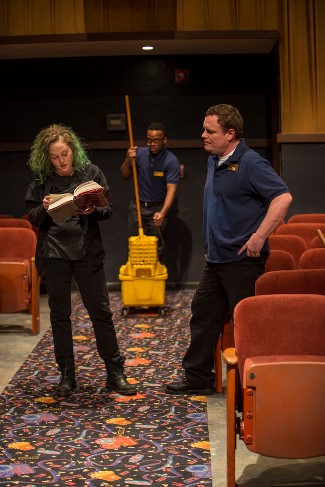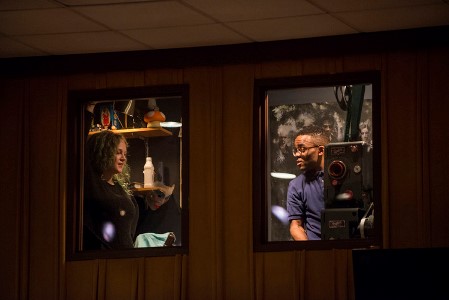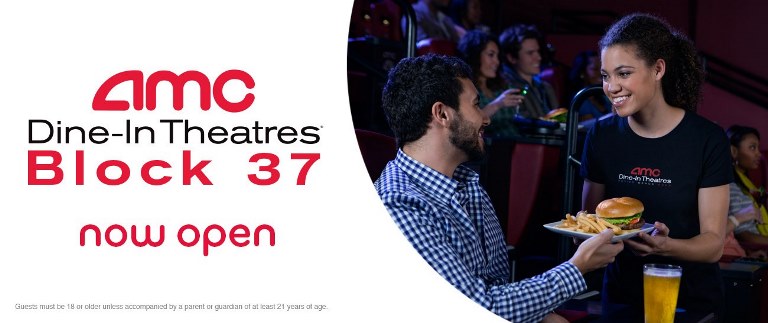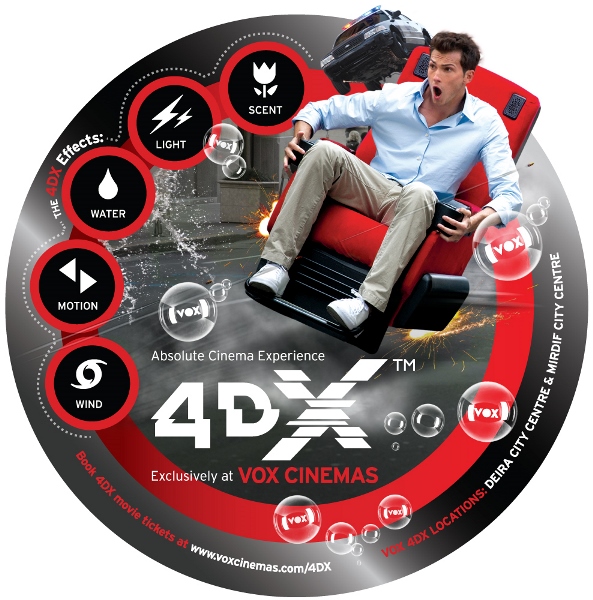
The Flick at Steppenwolf. Photo credit: Michael Brosilow
In 2012, when I was between gigs, I picked up a few shifts a week as a projectionist at a struggling movie theater, among the last in the city that had yet to convert to digital projection. It wasn’t an act of principled resistance or anything—the management was just too undercapitalized to acquiesce. I always got paid in cash at the end of the night—often in the manager’s office, in the dark, with the hours calculated in a hurried whisper. Never before had I held down a job that felt so unashamedly transactional.
The projection booth was grotty from years of neglect. Posters from the early ’90s covered up the stains on the wall. When I started there, the work room didn’t have a real rewind bench. The booth port holes didn’t even have any glass, but the auditorium was so large that no one would’ve heard anything up there anyway, unless a projector fell over.
And then one day, enough money had been miraculously borrowed from banks and scrounged up from couch cushions to buy a digital projector. The projectionists had a few weeks’ warning, but we were never explicitly told we’d be out of a job. I offered to help the manager set it all up, but he told me he’d be fine. Even though he was more a businessman than a cinephile, the manager wasn’t quite ready to let 35mm go. We’d still be running film for some shows and digital for others during the first week, so the projectionists kept their shifts.
I showed up for work on a Friday night, hours after the digital projector had been installed. I peeked inside the theater and saw a meager audience enjoying a Blu-ray screening of Indiana Jones and the Temple of Doom. I found the manager at the concession stand and asked how the afternoon had gone.
“Great,” he beamed, “there’s a movie running right now and no projectionist upstairs!”
• • •
I don’t think this episode makes me uniquely qualified to size up Annie Baker’s play The Flick, which runs through May 8 at Steppenwolf. (Disclosure: Julian Antos, NWCFS programmer and Music Box Theatre technical director, acted as a projection consultant for the Steppenwolf production.) If the Pulitzer Prize and the raft of rave reviews that greeted the Chicago premiere run are any indication, Baker has plenty of admirers among the ranks of non-projectionists. But anyone who’s ever worked in a movie theater, particularly a struggling one, will feel a strong affinity with The Flick, which chronicles a dead-end cinema in Worcester, Massachusetts, and the underpaid laborers who spend their days there.

The Flick at Steppenwolf. Photo credit: Michael Brosilow
Movie theaters attract a particular kind of employee, a profile that overlaps somewhat with broader low-wage, service sector employment but remains distinctly its own. A movie theater is a haven for stoned teenagers, college drop-outs, ex-riot grrls, perpetually-aspiring filmmakers and musicians, nervous men ambling towards middle age, and other marginalized folks. I’ve met all of Baker’s central characters a few times: Sam, the house manager who maintains a jokey exterior to deflect from the fact he’s going nowhere; Rose, the arty, off-kilter projectionist who throws spontaneous dance parties to blow off steam; Avery, the new assistant whose love of movies is simultaneously effusive and stunted. The Flick knowingly conveys the way that a day at a theater can be both highly regimented and surpassingly boring—there’s ample downtime between shows, punctuated by moments of controlled chaos. So long as the boss isn’t on the premises, it’s a pretty chill-ass vibe.
I have only a few quibbles with the way this world is portrayed in The Flick. For one thing, the respect accorded the projectionist by the front-of-house staff is somewhat exaggerated. It’s less a sense of awe than a wistful recognition that the projectionist doesn’t have to deal with crazy customers, filthy lobbies, and the constant scent of popcorn. When I was working at a five-screen art house in Rochester, New York, the projectionists made about fifty cents per hour more than the house staff, but the real perk was the unspoken understanding that we needn’t comply with the dress code or worry too much about the manager’s ALL CAPS ETIQUETTE TIPS in the weekly paycheck memo—those were never meant for us. (Projectionists also enjoyed the privilege of a private bathroom in the corner of the booth, so perhaps we really were the multiplex 1%.)
The Flick, the eponymous theater in Baker’s play, also seems unusually generous in scheduling long intervals between shows. House staff are usually expected to turn over an auditorium in two minutes or less to accommodate tight showtimes and constant audience churn. This minor detail is outweighed by Baker’s precise evocation of the endless expanse of time that greets a multiplex worker on a daily basis. Baker’s hyperrealist dialogue—sprinkled with movie references, sexual feints, gestures of impulsive resistance, and callbacks to inside jokes well past their sell-by dates—preserves the listless, low-key unease of working in a movie theater.
When The Flick debuted at Playwrights Horizons in 2013, it was a work of contemporary drama. Today it plays more like a period piece, as politically distant as a temperance melodrama. Pointedly set in the summer of 2012, when Django Unchained was nothing but the promise of a teaser poster beckoning from the corner of the lobby, The Flick bears witness to a vanished world of moviegoing. It’s not just Avery’s dreamy talk of 35mm screenings migrating to the emancipated catacombs. (Incidentally, this scenario recalls certain contemporaneous polemics published on this blog.) The bigger issue is the disappearance of independent, no-frills theaters. The digital transition has weeded out the undercapitalized amateurs.
 There are no more Flicks around to even face down an existential threat—the whole sector has been gentrified. Here in Chicago, the Logan revamped with an adjoining bar and lounge and the Davis will follow suit when it reopens in a few months, complete with Carbon Arc.
There are no more Flicks around to even face down an existential threat—the whole sector has been gentrified. Here in Chicago, the Logan revamped with an adjoining bar and lounge and the Davis will follow suit when it reopens in a few months, complete with Carbon Arc.
For the Chicago multiplex patron, there are more destinations than ever—and fewer choices once you reach them. The holiday season saw the opening of two premium venues: Chicagoland’s first Arclight in the North/Clybourn shopping district and its umpteenth AMC in the Loop’s Block 37 complex. The latter is a dine-in theater where the evening ticket price is $21.75—before accounting for dinner, which you’re supposed to order during the movie through the magic of ‘side-seat service.’ (So much for not talking during the movie.) The Arclight boasts its own novelties—it’s the first movie theater we’ve ever visited without a box office at the front and without a projection booth in the back. (Save for one auditorium, the projectors are enclosed in a snug, carpeted box protruding from the wall.) Each Arclight screening begins with an introduction from a personal greeter—very personal, almost uncomfortably so, in the case of the Christmas Eve matinee of Chi-raq, when I found myself to be the only customer in the auditorium. “Welcome to the latest Spike Lee Joint. Show of hands—you seen a Spike Lee Joint before? Yes, you.”
• • •
In the face of declining theatrical attendance, dreams of an upmarket re-brand have overtaken the whole exhibition industry. Venues that once fancied themselves as little more than concession-stands-that-also-showed-movies now offer reserved seating for all showtimes. Additionally, many theaters, such as Regal’s Webster Place, AMC’s 600 N. Michigan, and Landmark’s Century Centre Cinema, have converted some or all of their screening rooms to premium, extra-wide reclining seats. (Indeed, in some of the smaller auditoria, the seats feel wider than the screen itself.) The logic makes sense if you don’t think too hard about it: people have more entertainment options than ever these days, so the best hope of getting them out of their own damn house is to make the theater indistinguishable from their own damn house, right down to the La-Z-Boy in the living room. Perhaps some patrons enjoy these new seats and are more likely to trudge down to the multiplex because of them.

But from a business standpoint, the rise of the recliner is a sobering development that speaks to the diminished expectations in the exhibition sector. Fundamentally, the surging popularity of the over-sized recliner seat indicates that many theater owners believe they have excess capacity: the installation of recliners might cut an auditorium’s seating in half, but so what? How many times a week does a show even come close to selling out? Beyond a handful of Friday and Saturday evening shows, most theaters look like ghost towns the rest of the week, complete with Flavacol-battered tumbleweeds.
The new exhibition attitude was confirmed in a recent article about this trend in the Trib’s suburban Daily Southtown paper. Defending the recliner roll-out, AMC spokesman Ryan Noonan recalled that “[o]ther folks in the industry said, ‘You’re nuts — you’re taking out more seats than you’re putting back in.’ But attendance just shot through the roof . . . . We saw a 60 to 80 percent increase in attendance year-over-year even though we were losing 50 to 60 percent of our seating capacity.”
The multiplex model itself was designed to mitigate risk: instead of a single-screen theater finding itself stuck with a dud for a month while shouldering overhead on 2,000 empty seats, the multiplex allows theater managers to move their wares from auditorium to auditorium as the market dictates. Sure, smaller auditoriums limit the upside when there’s a hit, but they substantially limit the downside when there’s a flop. The movies that fail to draw an audience get shunted to the smaller auditoriums or even find their showtimes split with other underperformers. Conversely, a movie that draws a sufficiently large audience can be shown on multiple screens to accommodate increased demand.
Still, if you’ve got the showman’s disease, and your heartbeat quickens as you watch an audience file in, you can’t help but notice how success has been defined downwards. In the movie palace era, mass culture meant a few thousand people congregating for the sake of experiencing a movie together. With the multiplex, a good show meant a few hundred. But how often do a few hundred people show up in this day and age? For the dozen or so who might turn up for a given show, why not make a bid for their loyalty with overstuffed leather seats?

Thanks to Star Wars: The Force Awakens and a few other outsized blockbusters, the annual domestic box office tallied $11 billion for the first time in 2015. But as the Hollywood Reporter observed, the multiplex is increasingly a land of haves and have-nots. Big films like Jurassic World and Avengers: Age of Ultron give studios a license to mint money, and exhibitors continue to experiment with assorted up-charges that push blockbuster grosses ever higher: 3-D, 4DX, IMAX, IMAX 3-D, D-Box, ScreenX, the immersive ‘Barco Escape’ multi-screen process, assorted “premium-large format” auditoriums, adults-only auditoriums, etc. I learned from the Daily Southtown article that the Chicago Heights Cinema, operated by Marcus Theatres, has converted two of its auditoriums to “SuperScreen DLX.” (All these supercharged re-branding efforts just make a night at the movies sound like a trip to the condom aisle at CVS.)
But all the up-charges in the multiplex tool kit can’t goose the gross of a film that audiences genuinely don’t want to see. The studios found themselves in a similar position to Jeb (!) Bush: saturating the airwaves with ads just doesn’t compel people to buy a fundamentally unwanted product the way it once did. Gone are the days when agreeable middle-aged audiences and hormone-addled teenagers guaranteed a floor for practically any Hollywood movie.
In 2015, exhibitors were left holding the bag on movies that studios pushed out to 2,500 or 3,000 screens to no discernible audience: Jem and the Holograms, Rock the Kasbah, Our Brand is Crisis, We Are Your Friends, Victor Frankenstein. After breaking down their anemic grosses on a per-screen basis, we’re talking about films that attracted tens of patrons (and often low tens) at any given theater over the course of their opening weekends. The Walk, which Sony tipped as its early autumn Oscar contender, floundered in spite of its pricey 3-D and found itself out-grossed in its opening weekend by a Metropolitan Opera broadcast. Events like that used to be billed as ‘alternative content’ among exhibitors—but what if the movies themselves become the alternative content, competing for screens with ballets, boxing matches, and TV juggernauts like Games of Thrones and Sherlock? Godfrey Chesire predicted as much in his 1999 essay ‘The Death of Film/The Decay of Cinema,’ which looks more prescient with each passing year.
It’s this ungainly reality that could never coexist with the impassioned exhaustion of The Flick—the notion that movies are just one more thing in the world, rather than a community’s aesthetic and moral lodestar. And that makes me wonder whether The Flick wouldn’t play even better as a film. The economics of live theater dictate that a production should always strive to fill as many seats as possible, even if it requires a flood of industry comp tickets, and there’s something unsettling about taking in The Flick’s big, empty set amidst a Saturday night crowd. There’s an irrepressible energy in the audience—an energy that’s been deliberately wrung out of the action on stage. I suspect we can only truly commune with The Flick’s very special sense of loneliness during a sparsely-attended mid-morning matinee screening at a crumbling theater in an exurban strip mall. Look back—is anybody else even here?






















